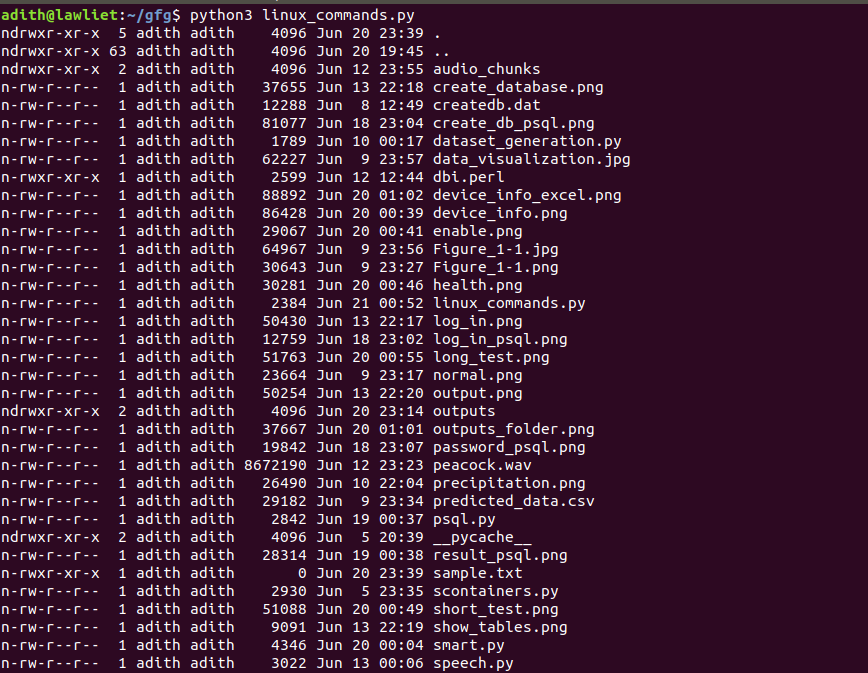Python|执行和解析 Linux 命令
先决条件: Linux Shell 和 Shell 脚本简介
Linux是最流行的操作系统之一,是开发人员的常见选择。它很受欢迎,因为它是开源的,它是免费的和可定制的,它非常健壮和适应性强。
一个操作系统主要由两部分组成:内核和Shell。内核基本上处理软件和硬件之间的通信。 shell 接受用户的输入或命令并产生输出。现在大多数 Linux 发行版都使用 BASH shell(Bourne again shell)。 Shell 命令和脚本非常强大,开发人员常用。
在本文中,我们将研究使用Python执行和解析 Linux 命令。
子流程——
Subprocess 是Python中的一个模块,它允许我们在Python中启动新的应用程序或进程。该模块旨在替换Python中的几个旧模块。我们可以使用这个模块来运行其他程序或执行 Linux 命令。
开始一个过程——
使用子进程模块中定义的 Popen函数可以生成一个新进程。它是 Popen 类的构造函数,它接受参数来设置新进程。该模块中的底层进程创建和管理由 Popen 类处理。
论据:
- The first parameter is a list that contains the commands and their options if any.
ex:['ls', '-l']
the above example is equivalent to typing ‘ls -l’ in the terminal - The second parameter is the stdout value. it specifies the standard output.
ex:stdout = subprocess.PIPE
This indicates that a new pipe or redirection should be created. The default value is
“None”, which means that no redirection will occur.
我们可以使用通信函数检索命令的输出。它从 stdout 和 stderr 读取数据,直到到达文件末尾并等待进程终止。它返回一个元组,其中包含输出数据和错误(如果有)。
句法:
data = subprocess.Popen(['ls', '-l', filename], stdout = subprocess.PIPE)
output = data.communicate()执行命令的输出存储在数据中。使用这些函数,我们可以执行 Linux 命令并获取它们的输出。
列出目录 –
我们可以使用带有“-l”、“-al”等选项的“ls”命令来列出当前目录中的所有文件。然后,我们可以解析此输出并以可呈现的格式打印它。 get_permissions()函数解析 list 命令的输出并仅检索文件的名称及其相应的权限。
# importing libraries
import subprocess
import os
# a function to list the files in
# the current directory and
# parse the output.
def list_command(args = '-l'):
# the ls command
cmd = 'ls'
# using the Popen function to execute the
# command and store the result in temp.
# it returns a tuple that contains the
# data and the error if any.
temp = subprocess.Popen([cmd, args], stdout = subprocess.PIPE)
# we use the communicate function
# to fetch the output
output = str(temp.communicate())
# splitting the output so that
# we can parse them line by line
output = output.split("\n")
output = output[0].split('\\')
# a variable to store the output
res = []
# iterate through the output
# line by line
for line in output:
res.append(line)
# print the output
for i in range(1, len(res) - 1):
print(res[i])
return res
# parse the output of the ls
# command and fetch the permissions
# of the files and store them in
# a text file .
def get_permissions():
# get the output of the
# list command
res = list_command('-l')
permissions = {}
# iterate through all the rows
# and retrieve the name of the file
# and its permission.
for i in range(1, len(res) - 1):
line = res[i]
line = line.split(' ')
folder_name = line[len(line) - 1]
permission_value = line[0]
permissions[folder_name] = permission_value
# create a directory called
# outputs to store the output files
try:
os.mkdir('outputs')
except:
pass
os.chdir('outputs')
# open the output file
out = open('permissions.txt', 'w')
out.write('Folder Name Permissions\n\n')
# write to the output file
for folder in permissions:
out.write(folder + ' : ' + permissions[folder] + '\n')
os.chdir('..')
return permissions
if __name__ == '__main__':
list_command('-al')
输出 : 
Ping 命令——
ping 命令代表 Packet Internet Groper。它最常用于检查两个系统或节点之间的连接。使用 ping 命令,我们可以检查一个节点与另一个节点之间的连接是否健康。它在两个节点之间交换数据包,并计算往返时间。
# importing libraries
import subprocess
import os
# a function to ping given host
def ping(host):
# command is pong
cmd = 'ping'
# send two packets of data to the host
# this is specified by '-c 2' in the
# args list
temp = subprocess.Popen([cmd, '-c 2', host], stdout = subprocess.PIPE)
# get the output of ping
output = str(temp.communicate())
output = output.split("\n")
output = output[0].split('\\')
# variable to store the result
res = []
for line in output:
res.append(line)
# print the results
print('ping results: ')
print('\n'.join(res[len(res) - 3:len(res) - 1]))
return res
if __name__ == '__main__':
# ping google
ping('www.google.com')
输出 : 
更改权限 –
chmod命令可用于更改文件权限。它是变化模式的缩写。更多信息可以在这里找到
# importing libraries
import subprocess
import os
# functio to change the permissions
# of a given file
def change_permissions(args, filename):
# command name
cmd = 'chmod'
# getting the permissions of
# the file before chmod
ls = 'ls'
data = subprocess.Popen([ls, '-l', filename], stdout = subprocess.PIPE)
output = str(data.communicate())
print('file permissions before chmod % s: ' %(args))
print(output)
# executing chmod on the specified file
temp = subprocess.Popen([cmd, args, filename], stdout = subprocess.PIPE)
# getting the permissions of the
# file after chmod
data = subprocess.Popen([ls, '-l', filename], stdout = subprocess.PIPE)
output = str(data.communicate())
# printing the permissions after chmod
print('file permissions after chmod % s: ' %(args))
print(output)
if __name__ == '__main__':
# changing the permissions of 'sample.txt'
change_permissions('755', 'sample.txt')
输出 : 